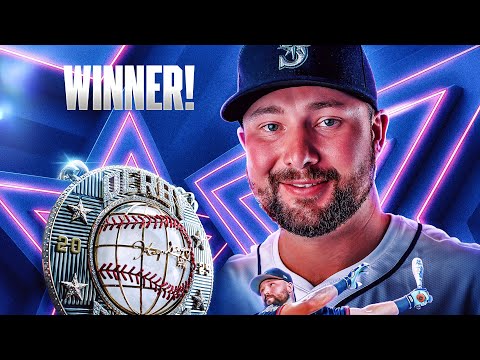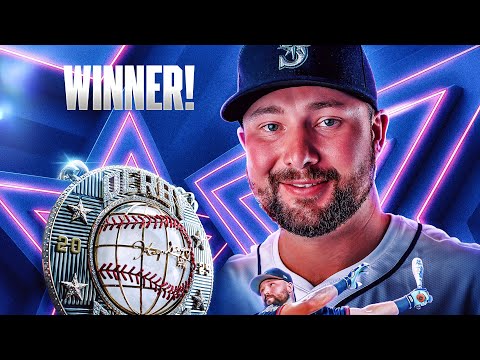How to revitalize baseball’s All-Star Game? Bat flips
ATLANTA — We need bat flips.
The home run swing-off to end Tuesday’s All-Star Game was great. Whether you embrace it as a revelation or dismiss it as a gimmick, baseball needs more of that kind of imagination on the national stage. On the morning after the game, it’s what you’re talking about.
But baseball cannot count on a tie score every summer.
The All-Star Game cannot live off old glories. The All-Star Game cannot thrive simply because the NFL turned the Pro Bowl into a flag football game and skills competition while the NBA turned its All-Star Game into a week of parties and 48 minutes of a defense-free scrimmages.
Baseball can say its All-Star Game is the best, but the bar is as low as the final round of a limbo competition. Baseball needs the best players, not the best available players, in the game. And, in an era dominated by social media and short attention spans, baseball needs innovation in the Home Run Derby — not just in an All-Star Game tiebreaker, but in the actual Home Run Derby that is its own Major Television Event on the night before the game.
The first suggestion, from Brent Rooker, the Athletics’ All-Star designated hitter: “I had the idea that we would just stick PCA (the Cubs’ Pete Crow-Armstrong) and (the Athletics’) Denzel Clarke in the outfield during the Home Run Derby and just let them run down balls. That’s a fun idea that popped into our clubhouse a few weeks ago.”
An all-in-one Home Run Derby and skills competition of outfielders contorting their bodies in all directions to make highlight-worthy catches? That’s a cool thought.
Bat flips would be better.
The bat flip, once scorned as an instrument of disrespect, is now celebrated by the league itself. It naturally lends itself to the “Did you see it?” reels young fans share on Instagram and Snapchat.
The first round of Monday’s Home Run Derby was exhausting. It took nearly two hours, and what little flash there was felt forced. Besides, the sluggers you most wanted to see — Shohei Ohtani and Aaron Judge — declined to participate.
“I already did it,” Judge said Tuesday. “I don’t know what else you want from me. I think it’s time for somebody else to step up and do their thing and have fun with it. I love seeing new faces in the game go out and do their thing.”
Said Dodgers pitcher and Hall-of-Famer-in-waiting Clayton Kershaw: “It’s a lot of swings, man. It’s not easy to do. When I used to hit, I was tired after taking six swings. I can’t imagine doing that for three straight hours.
“If Shohei and Aaron Judge and those guys, if they had them all in there, it would be awesome. You can’t expect those guys to do it every single year.”
So keep the eight-man field but split it into two groups: four players in the traditional format, and four players in a one-round competition judged not only by how many home runs you hit but with how much flair you toss your bat after each one.
Dodgers veteran pitcher Clayton Kershaw, tapping gloves with teammate Will Smith after pitching in the second inning during the All-Star Game.
(Daniel Shirey / MLB Photos via Getty Images)
The creative and outrageous dunks in the NBA‘s slam dunk competition go viral. The All-Star bat flips would too.
“With respect to an event like the Home Run Derby, we should continue to innovate,” Commissioner Rob Manfred said. “It’s fundamentally an entertainment product.”
There’s an idea, Rob. Run with it.
“The game piece of it? Fundamentally, I believe in the game,” Manfred said. “I think what we have to do is continue to work with our very best players to make sure that they’re here and showcasing themselves in front of a fan base that is really, really important to us over the long haul.”
Right now, all the very best players are not here. When MLB announced the All-Star rosters, the league selected 65 players. By game time, with all the replacements for players that withdrew, the All-Star count was up to 81.
That meant that, for every four players announced as an All-Star, one chose not to play.
“Usually, when you think All-Star Game, you think probably the best at the time in the game right now are going to be playing,” Phillies All-Star designated hitter Kyle Schwarber said.
Sometimes they are: On Tuesday, Schwarber was the most valuable player, with the winning swings in the swing-off.
Schwarber and Kershaw noted that, for the most part, the position players are here, and the pitchers dominated the list of missing stars. Pitchers throw harder these days. They need time to recover. Tony Clark, the executive director of the players’ union, talked about the need for players to find “opportunities on the calendar to take a breather.”
And, frankly, the All-Star Game does not mean nearly as much to players as it did before interleague play started 28 years ago. Winning one for the National League used to actually mean something.
“The All-Star Game then and the All-Star Game now are two completely different things,” Clark said. “The requirements for players, the travel and logistics for their family and support, the day to day of a 162-game season is more complex and it’s more challenging than it’s ever been.”
Yet in 1980, when the All-Star Game was played at Dodger Stadium, players had one free day before resuming the schedule. Today, players have two days.
And, in 1980, fans got to see the players they wanted to see. Should each team have an All-Star representative? Yes. Should managers feel compelled to use every one of those players? No way.
On Tuesday, the National League used 13 pitchers and the American League 11.
In 1980, each league used five pitchers. Steve Stone and Bob Welch each pitched (gasp) three innings. The top four batters in the American League lineup — Willie Randolph, Fred Lynn, Rod Carew and Reggie Jackson — each batted at least three times.
Today’s pitchers are reluctant to work even one inning in the All-Star Game if they pitched on the final weekend of the first half. So move the All-Star Game back one day to Wednesday, and move the Home Run Derby back one day to Tuesday. No longer would players have to scramble for Sunday night private jets to get to the All-Star Game by Monday morning.
As a bonus, MLB could play the Futures Game on Monday, when no other games are being played, instead of in relative invisibility because the league insists on putting what it says is a showcase event up against a full schedule of regular-season games.
“It would be great,” Clark said, “to just have a conversation around the All-Star Game and talk about the All-Star Game and the great players that we have, doing so in a way that truly highlights the Midsummer Classic and truly puts players in a position where they are sprinting to come to the game.”
And flipping their bats when they get here.



